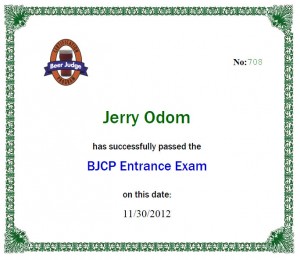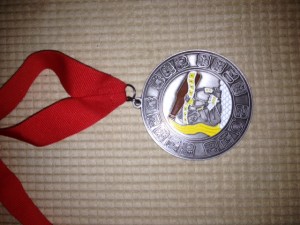So this should be interesting. I have a pound of Amarillo to use and a lot of American pale malt. Strike water is targeting 152F so infuse with 16 quarts of 165F water. Modify 6 gallons of water with 3/4 teaspoon gypsum. 1/3 teaspoon calcium chloride. Put 4 of that in the mash. Acidify the water first with lactic acid.
How it Went:
So the Mash hit appropriately on temperature. I decided to try batch sparging this time anticipating I’d get about the same efficiency at close to 70%. It was a far quicker process than my typical continuous technique and ran off the exact 1.04 pre-boil gravity. I was shocked really at how well it went. My boil went not quite right and the post boil gravity was 1.046 which I’m a little puzzled about. Fermentation took off extremely well and there was a nice 2 inch layer of yeast in less than 12 hours. I anticipate this being a nice beer.
I will likely stick with the batch sparge. It’s just too easy and gives the same results on my current equipment.
Tasting Notes From 12/26/2012:
Indeed it’s a very good beer. Good head retention, good aroma with some hops and some chocolate coming through. A bit nutty and chocolate in the taste. Body is medium and the finish is just barely a little astringent. It should smooth out to be very nice in about a month. The Amarillo hop is very nice in this beer. You just get that hint of citrus as a third or fourth flavor in this beer. It’s very subtle but makes this beer more complex and probably one that’ll score high in competition this year.
Tasting Notes From 1/3/2012:
The beer is still astringent. It lingers. I get almost a pineapple and then astringency. It’s annoying because other than that slightly too assertive character the beer is very good. Going to keep noting hoping to document the time for it to smooth out. I suspect I didn’t have enough sweetness to balance as a piece of chocolate made the astringency disappear completely. I believe I may up the crystal some next time.
Tasting Notes From 1/14/2012
Some time has done the hops well with this beer. Indeed it did smooth out completely and tastes very nice now. The finish on Amarillo hops is initially pine/pineapple like biting thing that smooths out more in to a nice citrus character. Perhaps in moer moderation next time.
Recipe Details
| Batch Size | Boil Time | IBU | SRM | Est. OG | Est. FG | ABV |
|---|---|---|---|---|---|---|
| 6 gal | 60 min |
Style Details
| Name | Cat. | OG Range | FG Range | IBU | SRM | Carb | ABV |
|---|---|---|---|---|---|---|---|
| American Brown Ale | 10 10C | 1.045 - 1.06 | 1.01 - 1.016 | 20 - 40 | 18 - 35 | 0 - 0 | 4.3 - 6.2 % |
Fermentables
| Name | Amount | % |
|---|---|---|
| Pale Malt (2 Row) US | 11 lbs | 88 |
| Caramel/Crystal Malt - 40L | 0.5 lbs | 4 |
| Chocolate Malt | 0.5 lbs | 4 |
| Caramel/Crystal Malt - 60L | 0.25 lbs | 2 |
| Caraamber | 0.25 lbs | 2 |
Hops
| Name | Amount | Time | Use | Form | Alpha % |
|---|---|---|---|---|---|
| Amarillo Gold | 1.75 oz | 0 min | Boil | 8.5 | |
| Amarillo Gold | 1 oz | 15 min | Boil | 8.5 | |
| Magnum | 0.75 oz | 60 min | Boil | Pellet | 14 |
Yeast
| Name | Lab | Attenuation | Temperature |
|---|---|---|---|
| California Ale V (WLP051) | White Labs | 73% | 150.8°F - 158°F |
Notes
| biscuit malt is actually 3 oz caraamber and 1 ounce melanoidin. ferment at 66F. Strike water is targeting 152F so infuse with 16 quarts of 165F water. Modify 6 gallons of water with 3/4 teaspoon gypsum. 1/3 teaspoon calcium chloride. Put 4 of that in the mash. Acidify the water first with lactic acid. |
Download
| Download this recipe's BeerXML file |
Name: Dirty Brown American Ale
Description: bjs uit malt is actually 3 oz caraamber and 1 ounce melanoidin. water modification same as last ipa. ferment at 66F.
Post Boil Volume: 6.00
Pre Boil Volume: 7.00
Mash Time: 60.00
Boil Time: 60.00
Desired Original Gravity: 1.05
Desired Final Gravity: 1.01
Calculated Likely ABV% Based on Specified Gravities: 5.260
Users Targeted ABV%: 5.000
Desired CO2 Volumes: 2
Anticipated Brewhouse Efficiency: 68
Likely Original Gravity at 6.00 Based on Grains and Efficiency: @ 68% = 304 GU = 1.051
Grain: Pale Malt (2 Row) US qty:11
Grain: Caramel/Crystal Malt – 40L qty:0.5
Grain: Caramel/Crystal Malt – 60L qty:0.25
Grain: Chocolate Malt qty:0.5
Grain: Caraamber qty:0.25
Hop : Magnum qty:0.75 at:60 mins. AA=14.00
Hop : Amarillo Gold qty:1 at:15 mins. AA=8.50
Hop : Amarillo Gold qty:1.75 at:0 mins. AA=8.50
Yeast: California Ale V qty:2 Max temp: 70.0 Min temp: 66.0
Style Name: American Brown Ale (American Ale)
Dirty Brown American Ale Pocket Brewer XML Code»
<?xml version=”1.0″ encoding=”utf-16″?>
<RecipeClass>
<BREWER>Pocket Brewer</BREWER>
<Type>All Grain</Type>
<VERSION>1</VERSION>
<OriginalGravity>1.05</OriginalGravity>
<OriginalGravityImportExport>1.05</OriginalGravityImportExport>
<FinalGravityImportExport>1.01</FinalGravityImportExport>
<FinalGravity>1.01</FinalGravity>
<BatchSize>6</BatchSize>
<BatchSizeImportExport>6</BatchSizeImportExport>
<BoilVolumeSize>7</BoilVolumeSize>
<BoilVolumeSizeImportExport>7</BoilVolumeSizeImportExport>
<CO2Volumes>2</CO2Volumes>
<BoilTime>60</BoilTime>
<MashTime>60</MashTime>
<TargetABV>5</TargetABV>
<BrewHouseEfficiency>68</BrewHouseEfficiency>
<Name>Dirty Brown American Ale</Name>
<Style />
<Description>bjs uit malt is actually 3 oz caraamber and 1 ounce melanoidin. water modification same as last ipa. ferment at 66F.</Description>
<StyleIdExact>10C</StyleIdExact>
<StyleIdGeneral>10</StyleIdGeneral>
<Yeasts>
<YeastAdditionClass>
<Quantity>2</Quantity>
<Name>California Ale V</Name>
<ProductID>WLP051</ProductID>
</YeastAdditionClass>
</Yeasts>
<Hops>
<HopAdditionClass>
<USE>Boil</USE>
<VERSION>1</VERSION>
<NOTES>German Hallertauer hybrid, widely used in Germany</NOTES>
<QuantityIO>0.75</QuantityIO>
<Quantity>0.75</Quantity>
<QuantityText>0.75</QuantityText>
<Alpha>14.00</Alpha>
<AlphaText>14.00</AlphaText>
<TinsethIBUS>30</TinsethIBUS>
<IsWholeHop>false</IsWholeHop>
<TimeInMinutes>60</TimeInMinutes>
<TimeInMinutesText>60</TimeInMinutesText>
<Name>Magnum</Name>
<Visible>Visible</Visible>
</HopAdditionClass>
<HopAdditionClass>
<USE>Boil</USE>
<VERSION>1</VERSION>
<NOTES>Unknown origin, but character similar to Cascade.</NOTES>
<QuantityIO>1</QuantityIO>
<Quantity>1</Quantity>
<QuantityText>1</QuantityText>
<Alpha>8.50</Alpha>
<AlphaText>8.50</AlphaText>
<TinsethIBUS>12</TinsethIBUS>
<IsWholeHop>false</IsWholeHop>
<TimeInMinutes>15</TimeInMinutes>
<TimeInMinutesText>15</TimeInMinutesText>
<Name>Amarillo Gold</Name>
<Visible>Visible</Visible>
</HopAdditionClass>
<HopAdditionClass>
<USE>Boil</USE>
<VERSION>1</VERSION>
<NOTES>Unknown origin, but character similar to Cascade.</NOTES>
<QuantityIO>1.75</QuantityIO>
<Quantity>1.75</Quantity>
<QuantityText>1.75</QuantityText>
<Alpha>8.50</Alpha>
<AlphaText>8.50</AlphaText>
<TinsethIBUS>0</TinsethIBUS>
<IsWholeHop>false</IsWholeHop>
<TimeInMinutes>0</TimeInMinutes>
<TimeInMinutesText>0</TimeInMinutesText>
<Name>Amarillo Gold</Name>
<Visible>Visible</Visible>
</HopAdditionClass>
</Hops>
<Grains>
<GrainAdditionClass>
<QuantityIO>11</QuantityIO>
<VERSION>1</VERSION>
<YIELD>79.00</YIELD>
<COLOR>2.0</COLOR>
<ORIGIN>US</ORIGIN>
<SUPPLIER />
<NOTES>Base malt for all beer styles</NOTES>
<Quantity>11</Quantity>
<PotentialSpecificGravity>1.036</PotentialSpecificGravity>
<Type>Grain</Type>
<Name>Pale Malt (2 Row) US</Name>
</GrainAdditionClass>
<GrainAdditionClass>
<QuantityIO>0.5</QuantityIO>
<VERSION>1</VERSION>
<YIELD>74.00</YIELD>
<COLOR>40.0</COLOR>
<ORIGIN>US</ORIGIN>
<SUPPLIER />
<NOTES />
<Quantity>0.5</Quantity>
<PotentialSpecificGravity>1.034</PotentialSpecificGravity>
<Type>Grain</Type>
<Name>Caramel/Crystal Malt – 40L</Name>
</GrainAdditionClass>
<GrainAdditionClass>
<QuantityIO>0.25</QuantityIO>
<VERSION>1</VERSION>
<YIELD>74.00</YIELD>
<COLOR>60.0</COLOR>
<ORIGIN>US</ORIGIN>
<SUPPLIER />
<NOTES />
<Quantity>0.25</Quantity>
<PotentialSpecificGravity>1.034</PotentialSpecificGravity>
<Type>Grain</Type>
<Name>Caramel/Crystal Malt – 60L</Name>
</GrainAdditionClass>
<GrainAdditionClass>
<QuantityIO>0.5</QuantityIO>
<VERSION>1</VERSION>
<YIELD>73.00</YIELD>
<COLOR>450.0</COLOR>
<ORIGIN>United Kingdom</ORIGIN>
<SUPPLIER />
<NOTES />
<Quantity>0.5</Quantity>
<PotentialSpecificGravity>1.034</PotentialSpecificGravity>
<Type>Grain</Type>
<Name>Chocolate Malt</Name>
</GrainAdditionClass>
<GrainAdditionClass>
<QuantityIO>0.25</QuantityIO>
<VERSION>1</VERSION>
<YIELD>75.00</YIELD>
<COLOR>30.0</COLOR>
<ORIGIN>US</ORIGIN>
<SUPPLIER />
<NOTES />
<Quantity>0.25</Quantity>
<PotentialSpecificGravity>1.035</PotentialSpecificGravity>
<Type>Grain</Type>
<Name>Caraamber</Name>
</GrainAdditionClass>
</Grains>
<Adjuncts />
<MISCS />
<WATERS />
<MASH>
<MASH_STEPS />
<VERSION>0</VERSION>
<GRAIN_TEMP>0</GRAIN_TEMP>
<TUN_TEMP>0</TUN_TEMP>
<SPARGE_TEMP>0</SPARGE_TEMP>
<PH>0</PH>
<TUN_WEIGHT>0</TUN_WEIGHT>
<TUN_SPECIFIC_HEAT>0</TUN_SPECIFIC_HEAT>
</MASH>
<Id>e08ff6ea-50ea-41a2-b1e3-4f76377ea45e</Id>
<BrewHouse>
<Efficiency>68</Efficiency>
</BrewHouse>
</RecipeClass>
<?xml version=”1.0″ encoding=”utf-16″?>
<RECIPE>
<NAME>Dirty Brown American Ale</NAME>
<VERSION>1</VERSION>
<TYPE>All Grain</TYPE>
<NOTES>bjs uit malt is actually 3 oz caraamber and 1 ounce melanoidin. water modification same as last ipa. ferment at 66F.</NOTES>
<BREWER>Pocket Brewer</BREWER>
<BATCH_SIZE>22.7115</BATCH_SIZE>
<BOIL_TIME>60</BOIL_TIME>
<BOIL_SIZE>26.4968</BOIL_SIZE>
<EFFICIENCY>68</EFFICIENCY>
<FG>1.01</FG>
<OG>1.05</OG>
<CARBONATION>2</CARBONATION>
<HOPS>
<HOP>
<NAME>Magnum</NAME>
<VERSION>1</VERSION>
<ALPHA>14.00</ALPHA>
<AMOUNT>0.0213</AMOUNT>
<USE>Boil</USE>
<TIME>60</TIME>
<NOTES>German Hallertauer hybrid, widely used in Germany</NOTES>
</HOP>
<HOP>
<NAME>Amarillo Gold</NAME>
<VERSION>1</VERSION>
<ALPHA>8.50</ALPHA>
<AMOUNT>0.0283</AMOUNT>
<USE>Boil</USE>
<TIME>15</TIME>
<NOTES>Unknown origin, but character similar to Cascade.</NOTES>
</HOP>
<HOP>
<NAME>Amarillo Gold</NAME>
<VERSION>1</VERSION>
<ALPHA>8.50</ALPHA>
<AMOUNT>0.0496</AMOUNT>
<USE>Boil</USE>
<TIME>0</TIME>
<NOTES>Unknown origin, but character similar to Cascade.</NOTES>
</HOP>
</HOPS>
<FERMENTABLES>
<FERMENTABLE>
<NAME>Pale Malt (2 Row) US</NAME>
<VERSION>1</VERSION>
<AMOUNT>4.9895</AMOUNT>
<TYPE>Grain</TYPE>
<YIELD>79.00</YIELD>
<COLOR>2.0</COLOR>
<ORIGIN>US</ORIGIN>
<SUPPLIER />
<NOTES>Base malt for all beer styles</NOTES>
<COARSE_FINE_DIFF>1.50</COARSE_FINE_DIFF>
<MOISTURE>4.00</MOISTURE>
<DISASTATIC_POWER>140.0</DISASTATIC_POWER>
<PROTEIN>12.30</PROTEIN>
<MAX_IN_BATCH>100.00</MAX_IN_BATCH>
<POTENTIAL>1.036</POTENTIAL>
</FERMENTABLE>
<FERMENTABLE>
<NAME>Caramel/Crystal Malt – 40L</NAME>
<VERSION>1</VERSION>
<AMOUNT>0.2268</AMOUNT>
<TYPE>Grain</TYPE>
<YIELD>74.00</YIELD>
<COLOR>40.0</COLOR>
<ORIGIN>US</ORIGIN>
<SUPPLIER />
<NOTES />
<COARSE_FINE_DIFF>1.50</COARSE_FINE_DIFF>
<MOISTURE>4.00</MOISTURE>
<DISASTATIC_POWER>0.0</DISASTATIC_POWER>
<PROTEIN>13.20</PROTEIN>
<MAX_IN_BATCH>20.00</MAX_IN_BATCH>
<POTENTIAL>1.034</POTENTIAL>
</FERMENTABLE>
<FERMENTABLE>
<NAME>Caramel/Crystal Malt – 60L</NAME>
<VERSION>1</VERSION>
<AMOUNT>0.1134</AMOUNT>
<TYPE>Grain</TYPE>
<YIELD>74.00</YIELD>
<COLOR>60.0</COLOR>
<ORIGIN>US</ORIGIN>
<SUPPLIER />
<NOTES />
<COARSE_FINE_DIFF>1.50</COARSE_FINE_DIFF>
<MOISTURE>4.00</MOISTURE>
<DISASTATIC_POWER>0.0</DISASTATIC_POWER>
<PROTEIN>13.20</PROTEIN>
<MAX_IN_BATCH>20.00</MAX_IN_BATCH>
<POTENTIAL>1.034</POTENTIAL>
</FERMENTABLE>
<FERMENTABLE>
<NAME>Chocolate Malt</NAME>
<VERSION>1</VERSION>
<AMOUNT>0.2268</AMOUNT>
<TYPE>Grain</TYPE>
<YIELD>73.00</YIELD>
<COLOR>450.0</COLOR>
<ORIGIN>United Kingdom</ORIGIN>
<SUPPLIER />
<NOTES />
<COARSE_FINE_DIFF>1.50</COARSE_FINE_DIFF>
<MOISTURE>4.00</MOISTURE>
<DISASTATIC_POWER>0.0</DISASTATIC_POWER>
<PROTEIN>10.50</PROTEIN>
<MAX_IN_BATCH>10.00</MAX_IN_BATCH>
<POTENTIAL>1.034</POTENTIAL>
</FERMENTABLE>
<FERMENTABLE>
<NAME>Caraamber</NAME>
<VERSION>1</VERSION>
<AMOUNT>0.1134</AMOUNT>
<TYPE>Grain</TYPE>
<YIELD>75.00</YIELD>
<COLOR>30.0</COLOR>
<ORIGIN>US</ORIGIN>
<SUPPLIER />
<NOTES />
<COARSE_FINE_DIFF>1.50</COARSE_FINE_DIFF>
<MOISTURE>4.00</MOISTURE>
<DISASTATIC_POWER>0.0</DISASTATIC_POWER>
<PROTEIN>13.20</PROTEIN>
<MAX_IN_BATCH>20.00</MAX_IN_BATCH>
<POTENTIAL>1.035</POTENTIAL>
</FERMENTABLE>
</FERMENTABLES>
<MISCS />
<WATERS />
<YEASTS>
<YEAST>
<NAME>California Ale V</NAME>
<TYPE>Ale</TYPE>
<VERSION>0</VERSION>
<FORM>Liquid</FORM>
<AMOUNT>2</AMOUNT>
<LABORATORY>White Labs</LABORATORY>
<PRODUCT_ID>WLP051</PRODUCT_ID>
<MIN_TEMPERATURE>66.0</MIN_TEMPERATURE>
<MAX_TEMPERATURE>70.0</MAX_TEMPERATURE>
<ATTENUATION>72.50</ATTENUATION>
<NOTES>Similar to White Labs California Ale Yeast, but slightly lower attenuation leaves a fuller bodied beer.</NOTES>
<BEST_FOR>American style Pales, Ambers, Browns, IPAs, American Strong Ale</BEST_FOR>
<FLOCCULATION>High</FLOCCULATION>
</YEAST>
</YEASTS>
<MASH>
<MASH_STEPS />
<VERSION>0</VERSION>
<GRAIN_TEMP>0</GRAIN_TEMP>
<TUN_TEMP>0</TUN_TEMP>
<SPARGE_TEMP>0</SPARGE_TEMP>
<PH>0</PH>
<TUN_WEIGHT>0</TUN_WEIGHT>
<TUN_SPECIFIC_HEAT>0</TUN_SPECIFIC_HEAT>
</MASH>
<STYLE>
<NAME>American Brown Ale</NAME>
<CATEGORY>American Ale</CATEGORY>
<CATEGORY_NUMBER>10</CATEGORY_NUMBER>
<STYLE_LETTER>C</STYLE_LETTER>
<STYLE_GUIDE>BJCP</STYLE_GUIDE>
<VERSION>1</VERSION>
<TYPE>Ale</TYPE>
<OG_MIN>1.045</OG_MIN>
<OG_MAX>1.060</OG_MAX>
<FG_MIN>1.010</FG_MIN>
<FG_MAX>1.016</FG_MAX>
<IBU_MIN>20</IBU_MIN>
<IBU_MAX>40</IBU_MAX>
<COLOR_MIN>18.0</COLOR_MIN>
<COLOR_MAX>35.0</COLOR_MAX>
<ABV_MIN>4.3</ABV_MIN>
<ABV_MAX>6.2</ABV_MAX>
<NOTES>A strongly flavored, hoppy brown beer, originated by American home brewers. Related to American Pale and American Amber Ales, although with more of a caramel and chocolate character, which tends to balance the hop bitterness and finish. Most commercial American Browns are not as aggressive as the original homebrewed versions, and some modern craft brewed examples. IPA-strength brown ales should be entered in the Specialty Beer category (23).</NOTES>
</STYLE>
</RECIPE>


